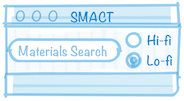From Composition to Structure: The SMACT Approach#
You’ve learnt to find chemically viable compositions through combinatorial screening and intelligent filtering. But here’s the next challenge: How do you predict what crystal structure those compositions will adopt?
This is where structure prediction becomes crucial. Having a composition like “LiCoO₂” tells you the recipe - but will it form a layered structure (good for batteries) or a spinel structure (different properties)? The crystal structure determines the material’s properties.
The Challenge of Structure Prediction#
Traditional structure prediction is quite difficult:
Quantum mechanical calculations are accurate but computationally expensive
Crystal structure databases only contain known materials
Experimental synthesis is time-consuming and may not work
Pure guessing has extremely low success rates
We need smarter approaches that leverage existing knowledge to predict new structures.
SMACT’s Substitution-Based Approach#
SMACT’s structure prediction module takes a data-driven approach based on a simple but powerful idea:
“Similar ions can often substitute for each other in crystal structures”
If we know that Na⁺ and K⁺ behave similarly (both large, singly-charged cations), then we can predict that compounds like KCl might adopt the same structure as NaCl.
This approach is based on the methodology from Hautier et al., who showed that ionic substitution patterns can be learnt from databases and used to predict new materials:
Hautier, G., Fischer, C., Ehrlacher, V., Jain, A., and Ceder, G. (2011)
Data Mined Ionic Substitutions for the Discovery of New Compounds.
Inorganic Chemistry, 50(2), 656-663.
doi:10.1021/ic102031h
How It Works: The Substitution Strategy#
The SMACT approach works in several steps:
1. Build a Structure Database#
Import known crystal structures from Materials Project/ICSD
Create a searchable database of structure-composition relationships
Focus on the most reliable, experimentally-validated structures
2. Learn Substitution Patterns#
Analyse which ionic substitutions occur frequently in nature
Build probability models based on ionic size, charge, and electronegativity
Create “lambda tables” that encode substitution likelihoods
3. Predict New Structures#
Take your target composition (e.g., from previous screening steps)
Find similar compositions in the database
Apply substitution rules to predict likely crystal structures
Rank predictions by probability
4. Validate and Refine#
Check chemical reasonableness of predictions
Calculate formation energies if needed
Provide confidence estimates based on similarity to known materials
What Makes This Useful#
The substitution-based approach offers several advantages:
Speed: Much faster than ab initio crystal structure prediction
Chemical basis: Based on real substitution patterns observed in nature
Reliability: Predictions are grounded in experimentally-validated structures
Integration: Works well with composition screening results
Interpretability: You can understand why a structure was predicted
Scalability: Can screen thousands of compositions quickly
However, this approach also has important limitations:
Conservative: Can only predict structures similar to known materials
Database dependency: Limited by the quality and coverage of your structure database
Incremental discovery: Unlikely to find radically new structural motifs
Substitution rules: Bound by statistical patterns that may not capture all possibilities
Building Toward Chemeleon#
The SMACT structure prediction approach represents the conventional way of doing computational materials discovery:
Start with known structures
Apply chemical rules and statistical analysis
Make incremental improvements through substitution
This approach works well when you want to explore variations of existing materials, but it has clear limitations. You can only predict structures that are chemically similar to what already exists in your database.
What if we could go beyond incremental changes? What if we could generate entirely new crystal structures from scratch, guided only by chemical principles and text descriptions? This is where Chemeleon comes in - offering an AI-driven approach to structure generation that can explore regions of chemical space not accessible through substitution methods.
What You’ll Learn#
In this section, we’ll explore:
Practical Skills#
How to set up and use SMACT’s structure prediction module
Building and querying structure databases
Implementing ionic substitution models
Generating and ranking structure predictions
Conceptual Understanding#
The principles behind substitution-based prediction
How to interpret and validate predictions
When this approach works well (and when it doesn’t)
How traditional methods prepare us for AI approaches
Real Applications#
Predicting structures for battery materials
Finding new phases in known chemical systems
Screening large numbers of compositions for structure types
Preparing inputs for more detailed computational studies
Integration with Previous Learning#
This section builds directly on everything you’ve learnt:
Combinatorial Explosion: Showed us the scale of chemical space
Chemical Filters: Taught us to eliminate impossible combinations
Compositional/Stoichiometry Screening: Generated viable compositions
Structure Prediction: Now predicts crystal structures for those compositions
The Path Forward#
By the end of this section, you’ll have solid grounding in traditional structure prediction methods. This foundation is essential for understanding and appreciating the new approaches that Chemeleon brings to the field.
Let’s begin exploring the world of ionic substitutions and data-driven prediction!
